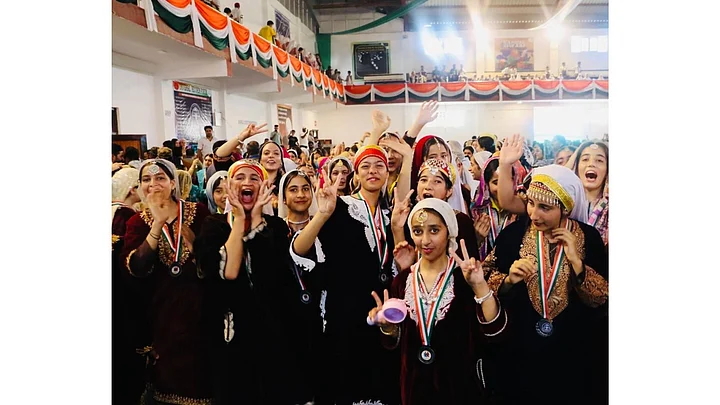In a historic feat, 10,000 young women from Baramulla created a world record by performing the Largest Kashmiri Folk Dance ever at the "Kashur Riwaaj" cultural festival. This mega event was organized by the Dagger Division of Chinar Corps in collaboration with Baramulla District Administration and Indrani Balan Foundation, as a run up celebration for the 78th Independence Day.
The festival took place at Prof. Showkat Ali Indoor Stadium to showcase the vibrant traditions of Kashmir through traditional dances, music, calligraphy and cultural activities. The highlight was the collective performance of the Rouf dance by the young women, setting a new world record.
"We have been rehearsing for almost a month. Now we feel all the effort was worth it. This is a great achievement and we are proud to be part of the world record," said one of the young participants.
The District Administration, led by Shri Minga Sherpa, DC, ensured the smooth execution of the event. Senior officials from the J&K Cultural Department, Police and NGOs were also present at the historic event and encouraged the participants.
The Chief Guest was Lt. Gen. Rajiv Ghai, Corps Commander of Chinar Corps, while Maj. Gen. Rajesh Sethi, GOC of Dagger Division and Baramulla Brigade Commander, Brigadier Rajat Bhatt, were also present on the occasion.
The Indrani Balan Foundation, led by Shri Punit and Smt. Janhavi Balan, have supported the initiative, continuing their involvement in various development and cultural activities in Baramulla. “This is a shining example of constructive engagement and cooperation between Civil-Military-Industry and the Youth”, said an official from the IBF.
This record-breaking event was adjudicated by the Universal Records Forum. Universal Records Forum (URF) is an ISO 9001:2015 certified organization, compliant to Guiness records standards, which underscores its commitment to maintaining quality management standards. This certification ensures that URF adheres to rigorous processes and standards in its operations, including record verification and adjudication.
A local professor commented, "Kashmiri culture is a melting pot of diversity, but today's youth show declining interest because it is not fashionable. The initiative of the army and district authorities has revived interest in our age-old traditions."
The Cultural Fest served as a vibrant showcase of Kashmiri artistry and talent from renowned local artistes. Attendees had the privilege of witnessing remarkable performances and celebrating the rich cultural heritage of Kashmir.
Ishfaq Hamid Bhatt, a 13-year-old prodigy, showcased his exceptional skills on the Rubab. Awarded the prestigious Pradhan Mantri Bal Puraskar 2024, Master Ishfaq is renowned for his remarkable talent and dedication to preserving Kashmiri musical traditions.
Mr. Naseer Ahmed Mir, a celebrated Santoor player, also performed at the fest. He has been awarded a gold medal by the President of India during the Kashmir University convocation in 2021, in recognition of his outstanding contribution to the art of Santoor playing. The Rubab and Santoor mini concert mesmerised the audience.
Mr. Shafi Mir, a calligraphy expert from Baramulla, was also part of the event. 70 years old, Mr. Mir has brought a lifetime of experience and skill to this craft. He also presented an intricate calligraphic work made on-the-spot to the Chief Guest.
The show was stolen by the passionate performance of the “Strings of Baramulla” band of the Chinar YUVA Centre. The audience was thrilled to see the popular RJs of Radio Baramulla take centre stage as the Master of Ceremonies. “It was a programme of the Youth, by the Youth, for the Youth of Baramulla” said RJ Harleen.
RJ Sajid added "This event has demonstrated the vibrant spirit of our young generation and their dedication to preserving our cultural heritage while embracing a sense of national pride.”
The Kashmir Valley is a historical melting pot of diverse ethnic groups and social structures, with its rich cultural tapestry evident in its language, dress, customs, rituals and history. The native language, Kashmiri, is a vital part of the region’s identity and has been shaped by Persian, Central Asian, and Indo-Aryan influences. Kashmir’s handicrafts, such as carpet weaving and Pashmina shawls, showcase exceptional artistry. Introduced by Persian and Central Asian weavers in the 15th century, Kashmiri carpets are renowned for their intricate designs. The Pashmina shawl is celebrated globally for its softness and detailed embroidery. Papier-mâché, known for its floral motifs and Persian-inspired patterns, dates back to the 14th century. The region’s cuisine, enriched by Persian and Afghan influences, features royal feasts and exquisite dishes. Kashmiri calligraphy, Sufi music, and the traditional "Rouf" dance highlight the valley’s artistic heritage. Ladishah, a form of musical storytelling that combines humor and satire to address social and political issues, has been revitalized by social media performers like Syed Areej Safvi, Kashmir’s first female Ladishah, who has brought this tradition to a modern audience through YouTube.
The Indrani Balan Foundation, a prominent non-profit organization, has made significant strides in Kashmir through its diverse initiatives. The foundation also supports the Dagger Parivaar School in Baramulla, the only such school for specially abled children in the region. Its community development projects focus on infrastructure improvements and vocational training. Heritage Centre at Boniyar in Kashmir was inaugurated by the Honble LG with a first of its kind laser show. This centre is part of their ongoing efforts to preserve and promote local culture and history.
The Indian Army remains closely connected with the people of Kashmir and actively supports the preservation of their heritage and traditions. The Army has worked alongside the community, contributing to the empowerment, education, skilling, infrastructure development and continuation of cultural practices and values, demonstrating a commitment to the region’s cultural legacy, while also guarding the nation’s borders and maintaining peace in the hinterland.
The success of 'Kashur Riwaaj' has set a benchmark for future cultural engagements in the region, uniting the youth of Kashmir in a display of tradition and patriotism.
(At The Quint, we question everything. Play an active role in shaping our journalism by becoming a member today.)
